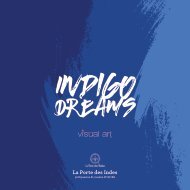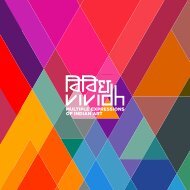Vividh 2016: Multiple Expressions of Indian Art
You also want an ePaper? Increase the reach of your titles
YUMPU automatically turns print PDFs into web optimized ePapers that Google loves.
working boots and with a spade. His portrait <strong>of</strong> Maya with<br />
her long hair seems pensive. <strong>Art</strong>ist-scholar KG<br />
Subramanyan's untitled woman looking upfront, eyes fixed<br />
and surrounded by birds and beasts for companionship,<br />
appears to come from another imagery world. Human<br />
portraits be it petite and curvaceous female figure or strong<br />
male form are also the playing fields in the work by Shanta<br />
Samant. Spiritual iconic form Lord Ganesh, invoked for<br />
auspicious beginnings, appears in a distinct incarnation in<br />
yet another work authored by SG Vasudev as a woven silk<br />
tapestry.<br />
The ability to stay rooted and indigenous while also<br />
absorbing and assimilating selective international practices,<br />
is mirrored in Jamini Roy's figuration <strong>of</strong> the three pretty<br />
maids or his Santhal carver. Noteworthy are the markings<br />
and symbols in the borders around his puppet like figures in<br />
flat colours. The work is clearly impacted by the folk arts and<br />
Kalighat Patua (rural art form <strong>of</strong> West Bengal) repertoire <strong>of</strong><br />
his native place. In yet another strand appears AA Raiba's<br />
narrative compositions titled Barahmasa (twelve<br />
months/seasons <strong>of</strong> the year) in one case and untitled in<br />
another. The fantasy-filled work draws its inspiration from<br />
Pahari (art style practiced in and around the mountains in<br />
Himachal) and Mughal miniature painting while younger<br />
artist Bhairavi Modi's art, though in different renditions,<br />
shares an interest in regional styles as reflected in her<br />
depiction <strong>of</strong> scenes and stories as enacted by some <strong>of</strong> her<br />
protagonists. Narratives surrounding people and life in<br />
urban and rural India or those based on classical or folk<br />
stories are at the center-stage in distinct work by<br />
distinguished artists Bhupen Khakhar, NS Bendre and<br />
Satish Gujral.<br />
Minimalist ethereal impressionistic compositions and Zen<br />
ambience comes to the fore in abstract and geometric<br />
renditions by some <strong>of</strong> the featured artists. It includes work by<br />
artists who were or have been based in the West, while<br />
simultaneously keeping their links with the sub-continent<br />
alive. A distinct ethnic touch within a glo-cal genre is<br />
reflected in their abstraction that treads both the worlds.<br />
Leading in this group is artist SH Raza who was based in<br />
Paris until his last few years and renowned for his work<br />
marked for its spiritual essence. Bindu (dot) and Prakriti<br />
(nature) are at the center stage in his colourful compositions<br />
encompassing circles, triangles, squares and half circles. A<br />
dot within a rhythmic pattern <strong>of</strong> circles, triangles and<br />
squares says it all, in Raza's oeuvre. His contemporary from<br />
London, Balraj Khanna's amazing white circular painting,<br />
features what reminds one <strong>of</strong> instruments, machine parts, or<br />
space creatures in contrast. This resonance <strong>of</strong> an<br />
otherworldly abstraction or neti-neti (neither this nor that)<br />
ambience is echoed in his multi-coloured painting featuring<br />
forms akin to toys, puppets and zebra like creatures. Also<br />
included in the grouping is banker cum artist Nayan<br />
Kisnadwala's work. His abstract paintings bordering on the<br />
tantric feature blooms and Shaligram (lingam). Inspired by<br />
colour therapy and numerology the works create a web <strong>of</strong><br />
spirals, lines and circles imbued with spiritual undertones.<br />
Master artist Ram Kumar's peaceful landscape in subtle<br />
colours entails markings suggestive <strong>of</strong> trees mountains<br />
rivers and paths while J Swaminathan's landscape in a more<br />
colourful and seductive composition features a series <strong>of</strong><br />
mountains with his trademark bird atop a mound and a<br />
lonesome tree in the distance. A contrast <strong>of</strong> sorts appears in<br />
brightly rendered landscapes by Nabibakhsh Mansoori that<br />
engage the viewer in a guftgu (conversation) in one work<br />
suggestive <strong>of</strong> mountains, rivers, horizon and fields while the<br />
other reverberates with an impression <strong>of</strong> a mirage. Sridhar<br />
Poluru evokes a different image <strong>of</strong> the landscape in a mix <strong>of</strong><br />
man animal and flora fauna while Paresh Maity's landscape<br />
with water, boats and habitation appears in a poetic stance.<br />
Popular culture with a touch <strong>of</strong> the cinematic and kitsch is<br />
played up in work by artists Dileep Sharma, and Nayanaa<br />
Kanodia, each shifting the focus to take in their current<br />
experiences surrounded by Bollywood and Mumbai society.<br />
The lady in a mini skirt and high heels appears with cropped<br />
small figures dancing atop and around her, in scissors; while<br />
in flying squad she adorns swimming costumes with high<br />
heels, jewelry and cosmetics as a tiny aircraft appears in a




